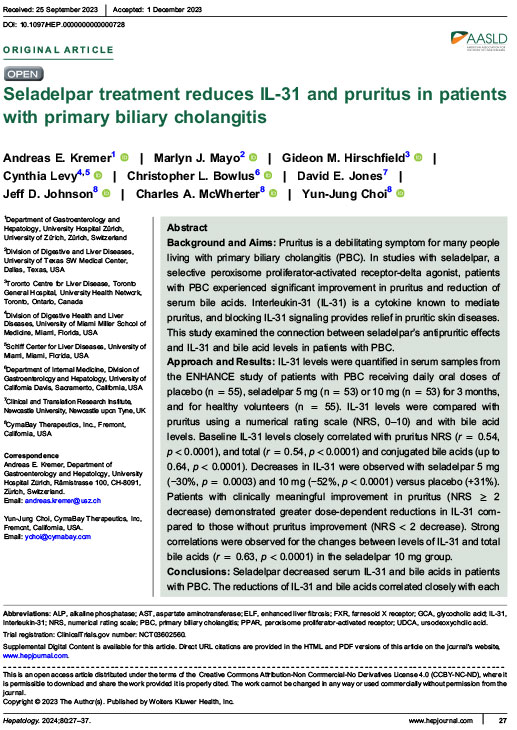Seladelpar treatment reduces IL-31 and pruritus in patients with primary biliary cholangitis
September 2023
Abstract
Background and Aims: Pruritus is a debilitating symptom for many people living with primary biliary cholangitis (PBC). In studies with seladelpar, a selective peroxisome proliferator-activated receptor-delta agonist, patients with PBC experienced significant improvement in pruritus and reduction of serum bile acids. Interleukin-31 (IL-31) is a cytokine known to mediate pruritus, and blocking IL-31 signaling provides relief in pruritic skin diseases.This study examined the connection between seladelpar’s antipruritic effects and IL-31 and bile acid levels in patients with PBC.
Approach and Results: IL-31 levels were quantified in serum samples from the ENHANCE study of patients with PBC receiving daily oral doses of placebo (n = 55), seladelpar 5 mg (n = 53) or 10 mg (n = 53) for 3 months, and for healthy volunteers (n = 55). IL-31 levels were compared with pruritus using a numerical rating scale (NRS, 0–10) and with bile acid levels. Baseline IL-31 levels closely correlated with pruritus NRS (r = 0.54, p < 0.0001), and total (r = 0.54, p < 0.0001) and conjugated bile acids (up to 0.64, p < 0.0001). Decreases in IL-31 were observed with seladelpar 5 mg (−30%, p = 0.0003) and 10 mg (−52%, p < 0.0001) versus placebo (+31%).Patients with clinically meaningful improvement in pruritus (NRS ≥ 2 decrease) demonstrated greater dose-dependent reductions in IL-31 compared to those without pruritus improvement (NRS < 2 decrease). Strongcorrelations were observed for the changes between levels of IL-31 and total bile acids (r = 0.63, p < 0.0001) in the seladelpar 10 mg group.
Conclusions: Seladelpar decreased serum IL-31 and bile acids in patients with PBC. The reductions of IL-31 and bile acids correlated closely with each other and pruritus improvement, suggesting a mechanism to explain seladelpar’s antipruritic effects.
Hepatology - Copyright © 2023 The Author(s). Published by Wolters Kluwer Health, Inc.
Note: Obeticholic acid, marketed under the brand name Ocaliva® for the treatment of primary biliary cholangitis (PBC), was voluntarily withdrawn from the US market by Intercept Pharmaceuticals following a request from the US Food and Drug Administration (FDA) on 11/14/2025

